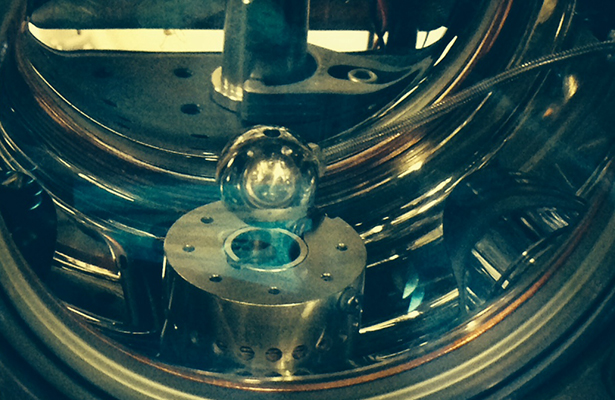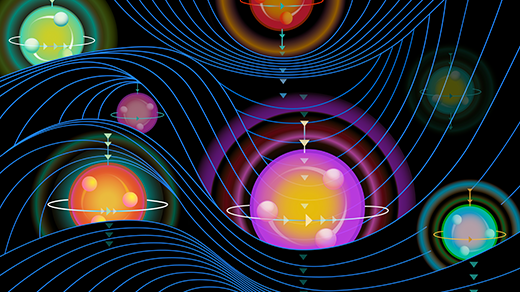Dark Energy Tested on a Tabletop

Dark energy has topped cosmologists’ “most wanted” list since 1998, when astronomers noticed that the expansion of the universe is speeding up rather than slowing down. The entity responsible — whatever it is — must be incredibly powerful, constituting nearly 70 percent of the universe. Figuring out the identity of this dark energy is “arguably the most important problem in physics,” said Clare Burrage of the University of Nottingham in the United Kingdom.
Now a team of physicists has directly tested one option for dark energy using not powerful telescopes or satellites, but a vacuum chamber fashioned on a tabletop.
The most straightforward explanation for dark energy is that it is the energy inherent in the vacuum of space itself. In this model, every teaspoonful of space brims with the same amount of dark energy, a value known as the cosmological constant. But there’s a major flaw in this simple solution. Physicists’ best calculation of this energy, which is thought to be due to the constant appearance and disappearance of “virtual” quantum particles, overshoots the actual observed value by a factor of 10120.
So perhaps instead of — or in addition to — the cosmological constant, there may be extra quantum fields, called scalar fields, that have a given strength at each point in space, just as a measurable temperature exists everywhere.
“We know there’s no explanation for the cosmological-constant problem within general relativity and the Standard Model of particle physics,” said Burrage. “Pretty much anytime you want to go beyond that, the new physics you try and introduce gives you new scalar fields.”
Scalar fields could produce dark energy in the fields’ lowest-energy, or vacuum, state, just as the cosmological constant would. But many proposed scalar fields interact with matter, which raises its own problem. If a scalar field interacts with ordinary matter — like the stuff that makes up Earth and the sun — its presence should already have been observed in our own solar system as an extra, unexplained force, and none has been seen. “If your theory of dark energy tells you these extra scalar fields are around, you have to explain why we haven’t seen them,” Burrage said.
One solution is that, like a chameleon, the field changes depending on the surrounding environment. Such a field would produce a negligible effect near high-density matter, like Earth, slipping by unnoticed in the presence of the stronger, familiar force of gravity. But in the emptiness of space between galaxies, it would produce a long-range pull. (Unfortunately, this pull would still be imperceptible to astronomers, since it would disappear around large objects whose movements they could track.)
Chameleon models are not especially well motivated from the standpoint of fundamental physics, admits Burrage, who began studying them in graduate school, but since dark energy presents such a profound mystery, physicists are willing to consider just about anything.
Last August, Burrage and her colleagues posted a paper on the scientific preprint site arxiv.org suggesting a way to lay a trap for these cagey cosmic chameleons. They envisioned a vacuum chamber about the size of a bowling ball with a marble-size sphere at its center. The chameleon field, assuming it was there, would be minimized near the walls of the chamber and immediately around the central sphere. It would have a higher value in the empty space between them. That means that an atom — whose own mass is too small to kill off the chameleon field — placed inside the vacuum chamber would feel a different force from the field depending on its position in the chamber.
Pulses of laser light could be used to track the atom’s movement in the chamber at three different times. If the tracking revealed an unexplained acceleration, it could be due to the force of a chameleon field. “You use the light beam as a ruler, and you just watch the atoms moving across the ruler,” said Ed Hinds, the head of the Center for Cold Matter at Imperial College London and the lead experimentalist on the team proposing the test.
After devising the chameleon trap, Hinds and his team set out to build it; he expects to get the first results in a few months. But other physicists led by Holger Müller at the University of California, Berkeley, already had a similar setup in their lab, so they got a head start on the tests and reported their first results in a paper posted to arxiv.org on Feb. 13 and submitted to a prominent peer-reviewed journal. (Müller declined to comment for this article, as the journal’s policies forbid him from speaking directly to the media until shortly before the paper is published.)
Using cesium atoms as the test particles, Müller’s team found that the atoms’ movement did not change depending on their distance from the sphere. That ruled out most chameleon models that could account for dark energy, Müller reported at a talk at Harvard University on Feb. 23.
The result came out “exactly as I predicted, so it’s a little bit galling that it wasn’t in my lab,” Hinds said. “But I must say they’ve done a very fine job.” Hinds believes that the test can be made 1,000 times more sensitive, allowing him to probe energies close to the scale where quantum mechanics becomes important for gravity. But he is closemouthed about how he plans to get there. “I need to have some way to come back at the Berkeley people,” he joked.
Lam Hui, a theoretical astrophysicist at Columbia University, said such experiments are interesting, but not for their ability to shed light on dark energy. That is because cosmic acceleration, according to chameleon models, would be caused not by any camouflaging behavior on the part of the field but simply by the value of its lowest-energy state. Instead, the experiments are “testing the chameleon mechanism,” he said — the general idea that the universe could harbor undetected scalar fields that interact with matter.
Mikhail Lukin, a physicist at Harvard who attended Müller’s talk there, said the method holds a lot of promise. Such high-precision instruments should “really push the frontier of our understanding of the universe,” he said, but he added that “the big thing would be to really observe something” rather than rule models out.
To date, cosmological observations have had an edge in this regard, said Ronald Walsworth, another Harvard physicist at the talk. “They’ve actually seen effects that we can’t explain,” he said, referring to the observations that revealed dark energy.
Still, some of those who trade in cosmic observations are impressed with the new study. “That was a very neat idea,” said Valeria Pettorino of the University of Heidelberg in Germany. “It’s quite different from other kinds of tests we are used to for dark energy.” She led a team that recently compared the predictions of various models of dark energy with observations from the Planck satellite and other telescopes. The combined data from all sources revealed the faintest hint of a deviation from the simplest dark-energy model based on the cosmological constant.
If chameleon models are one day ruled out completely, “then that is great,” said Amanda Weltman of the University of Cape Town in South Africa, who co-developed the first such models more than a decade ago. “It is exciting to be able to propose a theory that can be tested and ruled out in a reasonable time frame.”
This article was reprinted on ScientificAmerican.com.



